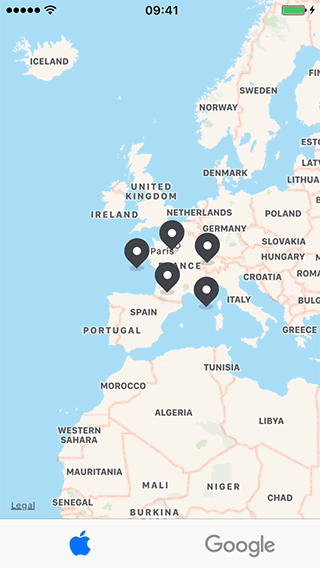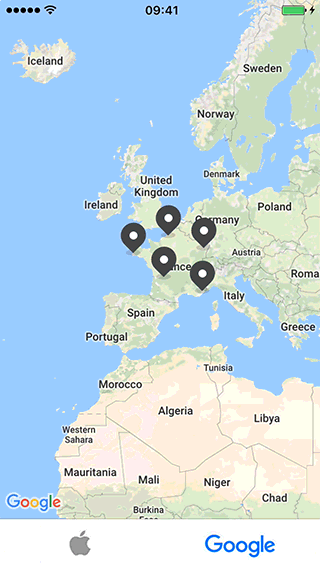ClusterKit is an elegant and efficiant clustering controller for maps. Its flexible architecture make it very customizable, you can use your own algorithm and even your own map provider.
- Native supports of MapKit and GoogleMaps.
- Comes with 2 clustering algorithms, a Grid Based Algorithm and a Non Hierarchical Distance Based Algorithm.
- Annotations are stored in a QuadTree for efficient region queries.
- Cluster center can be switched to Centroid, Nearest Centroid, Bottom.
- Handles pin selection as well as drag and dropping.
- Written in Objective-C with full Swift interop support.
ClusterKit is available through CocoaPods. To install
it, simply add the following line to your Podfile:
pod 'ClusterKit'With Carthage, add the following to your Cartfile:
github "hulab/ClusterKit"If you want to use ClusterKit with Mapkit or GoogleMaps, please follow the Installation Guide.
If you want to try it, simply run:
pod try ClusterKit
Or clone the repo and run pod install from the Examples directory first.
Provide the Google API Key in the AppDelegate in order to try it with GoogleMaps.
CKNonHierarchicalDistanceBasedAlgorithm *algorithm = [CKNonHierarchicalDistanceBasedAlgorithm new];
self.mapView.clusterManager.algorithm = algorithm;
self.mapView.clusterManager.annotations = annotations;- (void)mapView:(MKMapView *)mapView regionDidChangeAnimated:(BOOL)animated {
[mapView.clusterManager updateClustersIfNeeded];
}
- (void)mapView:(MKMapView *)mapView didSelectAnnotationView:(MKAnnotationView *)view {
if ([view.annotation isKindOfClass:[CKCluster class]]) {
CKCluster *cluster = view.annotation;
if (cluster.count > 1) {
[mapView showCluster:cluster animated:YES];
}
}
}CKGridBasedAlgorithm *algorithm = [CKGridBasedAlgorithm new];
self.mapView.clusterManager.algorithm = algorithm;
self.mapView.dataSource = self;
self.mapView.clusterManager.annotations = annotations;- (void)mapView:(GMSMapView *)mapView idleAtCameraPosition:(GMSCameraPosition *)position {
[mapView.clusterManager updateClustersIfNeeded];
}
- (BOOL)mapView:(GMSMapView *)mapView didTapMarker:(GMSMarker *)marker {
if (marker.cluster.count > 1) {
GMSCameraUpdate *cameraUpdate = [GMSCameraUpdate fitCluster:marker.cluster];
[mapView animateWithCameraUpdate:cameraUpdate];
return YES;
}
return NO;
}- (GMSMarker *)mapView:(GMSMapView *)mapView markerForCluster:(CKCluster *)cluster {
GMSMarker *marker = [GMSMarker markerWithPosition:cluster.coordinate];
if(cluster.count > 1) {
marker.icon = <#Cluster icon#>;
} else {
marker.icon = <#Annotation icon#>;
}
return marker;
}Assets by Hugo des Gayets.
ClusterKit is available under the MIT license. See the LICENSE file for more info.







